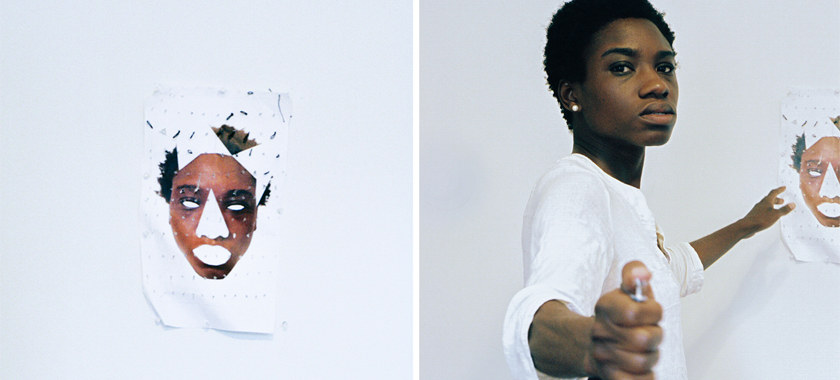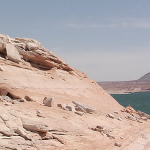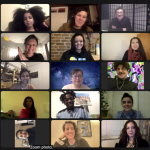Business of Art | Digital Marketing for Artists
How to align your digital marketing efforts with your artistic goals, from marketing specialist Molaundo Jones.
Digital marketing is an essential part of being an artist of any discipline. And while creating and maintaining a website, sending out emails, and being active on social media can feel stressful and overwhelming, it doesn’t have to be. One key to navigating these digital waters is determining your goals, and working from there to chart where to spend your time and energy.
Here, we break down how to set goals and use your website and social media effectively, courtesy of Molaundo Jones, Founder of The Clever Agency and Senior Director of Communications and Partnerships at Art21.
Where to Start
If you can start with specific objectives, then you can have a more sustainable approach to your marketing efforts.
According to Jones, a key question to ask is “What are my goals?” Do you want to sell your work, encourage people to buy tickets to your event, increase engagement with your content, or establish yourself as an expert? You can have multiple goals, but it is best to focus on a few that you’ll be able to work towards and track progress on.
You’ll also want to determine your target audience/s. The more clearly you identify who they are, says Jones, the better you can market to them. For example, if you have a target audience of urban youths who are 15-25 years old and also want to reach an elderly population of 65 and over, that’ll help you to determine what those audiences relate to and respond to. It’ll also help you to create assets and copy that will appeal to those audiences, and hone your voice so that it appeals to your target audiences.
Once you have an idea of your target audience, consider what type of content they respond to. Jones emphasizes that you’ll want your efforts to be data-driven, something we’ll get into a little further into this post. One way to begin is by looking at what people you consider to be your peers are doing. “Identify folks who are doing it well, and see how they are doing it,” says Jones. “No idea is original, so don’t feel bad about identifying someone who is doing it well and tailoring it and adapting it to your style, your language, and your target audience,” he added.
Website
Jones says that you should view your website as a visual resume, and a must-have for artists of all disciplines. Having a website is “one of the lowest bar investments you can make in yourself as an artist,” says Jones, who added that it is important to have “visual real estate that people from around the world can access.”
There are several free or relatively low-cost platforms where you can create one of your own with minimal technical skills required. Jones cited Weebly for being one of the very few popular website hosting platforms that offers a completely free service. Other options are Squarespace, a personal favorite of Jones’s for the simplicity of its design templates, and Wix, which offers hundreds of templates to choose from.

Once you have a website, you will be able to access data on who is coming to your site, from where, and at what times. Most of the web platforms mentioned above include built-in analytics, but Jones suggests connecting it with Google Analytics to enable deep dives into learning about your audience. Using this tool, you can determine whether you’re growing or losing visitors over time, where in the world people are visiting from, how they are coming to your website, and more.
When building out your content, consider SEO, or search engine optimization, which is the process of improving the quality and quantity of website traffic to a website or a web page from search engines. To put the idea of SEO into practice, we searched “search engine optimization” in Google and found this top result–a Beginner’s Guide to SEO. Jones encourages that you focus on keywords that are relevant to your website, the type of work that you’re making, and the profession that you’re in. For example: if your work involves socially-engaged art, then you could consider including keywords like “social practice,” “socially engaged art,” and “art and social justice.”
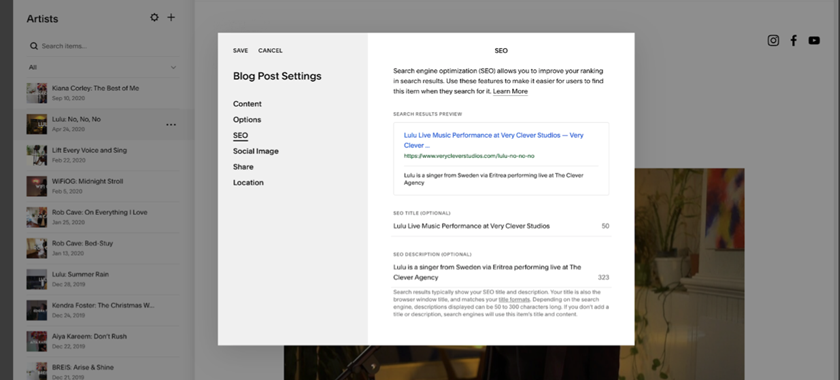
Social Media
First things first: you do not need to be on every single social media platform (Facebook, Instagram, Twitter, TikTok, YouTube, LinkedIn, etc.) and you do not need to post every day! Jones suggests thinking about the platform/s that suit you and your work most and where your audience is, then tailoring your content to fit those platforms.
Jones notes that consistency is key, advising that you plot out days and times that you’ll post based on what your capacity for social media marketing is. For example, post on your preferred channel/s once or twice a week, making sure that you post around the same day and time to create an expectation from your followers on when they can see your content. Scheduling tools such as Hootsuite, Sprout Social, Buffer, and Hubspot can help in this department, enabling you to schedule posts in advance and dedicate set days and times to this part of your practice.
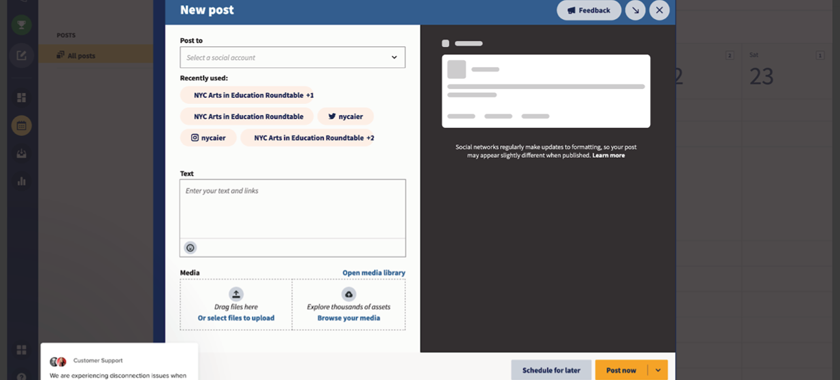
Jones acknowledges that posting every day is typically the best strategy for maximum growth; for artists with this capacity, be careful not to inundate their followers with content (hint: leave room to breathe!). Remember, if you do not have the capacity that is totally OK as long as you are being consistent with your output! You’ll also want to think about if and how video can be part of your social media strategy, as video is being prioritized on channels like Facebook and Instagram to compete with newer, youth-skewing platforms like Tik Tok.
To deepen your understanding of your audience, Jones suggests creating a free business profile on Facebook and Instagram. With a business account, you’ll be able to access insights that can help you better understand your audience and the type/s of content they respond to. With this type of account, you can also create paid promotions that can help get your content seen and shared. While you can’t target on an individual basis, you can use this tool to reach people by geography, interest/s, gender, and more. This is particularly advantageous as ever-changing social media algorithms don’t always show your content to your fans and followers. Putting money behind your posts will help get eyes on it, from both your own audience and from folks that you target.
Some additional social media best practices? Jones says to prioritize engagement over followers and create “Sacred Hashtags” that are like your website SEO–enabling people to land on your content when they search for specific things like #AfroFuturism, #NewMusic, or #PerformanceArt. He advises using a few “Sacred Hashtags” each time you post, then adding other relevant hashtags depending on the content that you’re posting. The more you use hashtags, the more likely your content will appear when people are browsing hashtags. Also: follow the people that you want to work with, and engage with their content in an authentic way.
In Closing
The tips and tricks above are just the tip of the iceberg when considering your digital presence. Don’t forget about email, for example, as Jones notes that it is still one of the best ways to reach out to your target audience, yielding higher engagement rates than social media. There are platforms that can help you to streamline your design, schedule emails, and get analytics to better understand your audience: Mailchimp, Constant Contact, Hubspot, and Moosend among them.
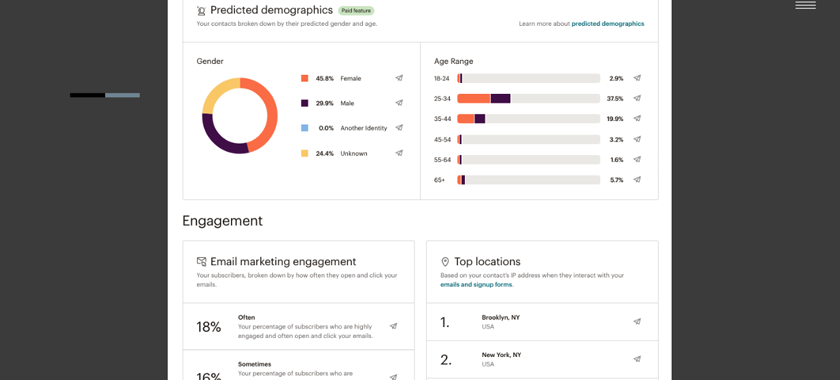
If you’re feeling stuck, there are myriad online resources and apps that can help you to create and share content, many that are free or low-cost that you can download on your phone. You can also poll people in your network to see what channels they are using and how, then take inspiration from their strategy to help inform what might work best for you. For further advice, read our Web Design 101 and The Three C’s of Online Marketing blog posts.
–Compiled by Amy Aronoff, Senior Communications Officer
You can find more articles on arts career topics by visiting the Business of Art section of NYFA’s website. Sign up for NYFA News and receive artist resources and upcoming events straight to your inbox.
NYFA Learning provides artists, creators, students, and arts administrators with tools, strategies, and advice for building sustainable careers. We collaborate with organizations, academic institutions, and cultural partners to bring our programs to a broad range of national and international creative communities.

